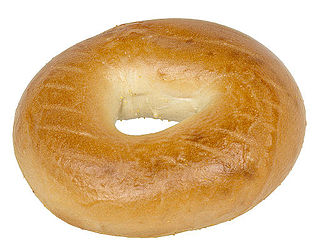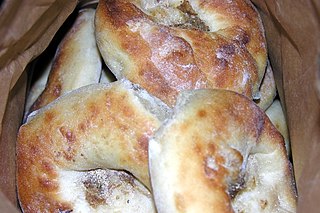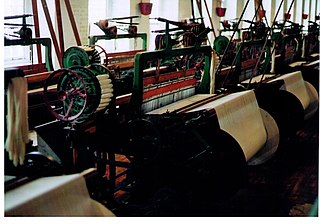Related Research Articles

A bagel, also historically spelled beigel, is a bread product originating in the Jewish communities of Poland. It is traditionally shaped by hand into the form of a ring from yeasted wheat dough, roughly hand-sized, that is first boiled for a short time in water and then baked. The result is a dense, chewy, doughy interior with a browned and sometimes crisp exterior. Bagels are often topped with seeds baked on the outer crust, with the traditional ones being poppy or sesame seeds. Some may have salt sprinkled on their surface, and there are different dough types, such as whole-grain or rye. Bagels are eaten toasted or untoasted.

A chicken nugget is a chicken product made from chicken meat that is breaded or battered, then deep-fried or baked. Invented in the 1950s, they have become a popular fast food restaurant item, as well as commonly sold as a frozen product for home use.

Conveyor belt sushi, also called "rotation sushi" is a form of sushi restaurant common in Japan. In Australasia, it is also known as a sushi train.

Philippe's, or "Philippe the Original" is a restaurant located in downtown Los Angeles, California. The restaurant is well known for continuously operating since 1908, making it one of the oldest restaurants in Los Angeles. It is also renowned for claiming to be the inventor of the French dip sandwich.

Shoemaking is the process of making footwear.

Bialy, a Yiddish word short for biały or bialystoker kuchen, from the city of Białystok in Poland, is a small roll that is a traditional dish in the Polish Ashkenazi Jewish cuisine.

Canter's Deli is a Jewish-style delicatessen, opened in 1931 in Boyle Heights, and later moved to the Fairfax District of Los Angeles, California, near the border of West Hollywood, where it is now. It has been frequented by many notable movie stars and celebrities.

Schwartz's, also known as the Montreal Hebrew Delicatessen, is a delicatessen restaurant and take-out, located at 3895 Saint-Laurent Boulevard in Montreal, Quebec. It was established in December 31, 1928 by Reuben Schwartz, a Jewish immigrant from Romania. Its long popularity has led to it being considered a cultural institution of Montreal.

Lender's Bagels is a brand of bagels that pioneered the pre-packaged bagel industry in the United States. Established in 1927 in New Haven, Connecticut by the Lender family, it became a North American leader in the marketing, distribution and sales of bagels. Lender's introduced frozen bagels and sold the first packaged bagels in supermarkets, eventually becoming the world's biggest bagel producer. The company was sold to Kraft Foods in 1984. In 2003, it became part of Pinnacle Foods. In 1994 it began production of room temperature fresh bagels. In 2012, Lender's revenue was about $70 million.

A California roll or California maki is a makizushi sushi roll that is usually rolled inside-out, and containing cucumber, crab or imitation crab, and avocado. Sometimes crab salad is substituted for the crab stick, and often the outer layer of rice in an inside-out roll (uramaki) is sprinkled with toasted sesame seeds or roe such as tobiko from flying fish ).

An everything bagel is a popular type of bagel, allegedly invented by David Gussin, that includes a large variety of toppings; the exact ingredients depend on the vendor.

A flour tortilla or wheat tortilla is a type of soft, thin flatbread made from finely ground wheat flour. It was originally derived from the corn tortilla, a flatbread of maize which predates the arrival of Europeans to the Americas. Made with a flour and water based dough, it is pressed and cooked similar to corn tortillas. The simplest recipes use only flour, water, fat, and salt, but commercially-made flour tortillas generally contain chemical leavening agents such as baking powder, and other ingredients.

The Northrop Loom was a fully automatic power loom marketed by George Draper and Sons, Hopedale, Massachusetts beginning in 1895. It was named after James Henry Northrop who invented the shuttle-charging mechanism.
The Bagel Bakers Local 338 was a trade union local that was established in the early 1900s in New York City and whose craftsmen were the primary makers of New York's bagels, prepared by hand, until the advent of machine-made bagels in the 1960s led to its end as an independent organization in the 1970s. It was a local union of the Bakery and Confectionery Workers International Union. Until 1964, the union used a different transliteration and called itself the Beigel Bakers Union.

The Thor washing machine was the first electric clothes washer sold commercially in the United States. Produced by the Chicago-based Hurley Electric Laundry Equipment Company, the 1907 Thor is believed to be the first electrically powered washer ever manufactured, crediting Hurley as the inventor of the first automatic washing machine. Designed by Hurley engineer Alva J. Fisher, a patent for the new electric Thor was issued on August 9, 1910, three years after its initial invention.
Dichotomie is a two-movement composition for solo piano by the Finnish composer Esa-Pekka Salonen. The work was completed in October 2000 and was first performed by pianist Gloria Cheng on December 4, 2000 in Los Angeles.
Daniel Thompson was a Canadian-born American inventor and entrepreneur. Thompson was best known as the inventor of the first commercially viable bagel machine, which allowed for the mass production and mass marketing of the bagel to a wider consumer market.

A bagel, also historically spelled beigel, is a bread product originating in the Jewish communities of Poland. It is traditionally shaped by hand into the form of a ring from yeasted wheat dough, roughly hand-sized, that is first boiled for a short time in water and then baked. The result is a dense, chewy, doughy interior with a browned and sometimes crisp exterior. Bagels are often topped with seeds baked on the outer crust, with the traditional ones being poppy or sesame seeds. Some may have salt sprinkled on their surface, and there are different dough types, such as whole-grain or rye. Bagels are eaten toasted or untoasted.
Hjalmar Gotfried Carlson was an American sheet metal worker, expert in metal drawing, superintendent, and inventor, who worked in Worcester, Massachusetts. He is known for being awarded the first ASME Medal in 1921, and the first Holley Medal in 1924.

A bagel and cream cheese is a common food pairing in American cuisine, the cuisine of New York City and Philadelphia, and American Jewish cuisine, consisting in its basic form of an open-faced sandwich made of a bagel spread with cream cheese. The bagel is typically sliced into two pieces, and can be served as-is or toasted. The basic bagel with cream cheese serves as the base for other sandwiches such as the "lox and schmear", a staple of delicatessens in Philadelphia and the New York area, and across the U.S.
References
- 1 2 3 Woo, Elaine (2015-09-19). "Daniel Thompson dies at 94; his invention made bagel a household word". Los Angeles Times. ISSN 0458-3035 . Retrieved 2017-09-19.
- 1 2 Kaplan, Sarah (2015-09-22). "The inventor who revolutionized and maybe ruined the bagel, dead at 94". Washington Post. ISSN 0190-8286 . Retrieved 2017-09-19.